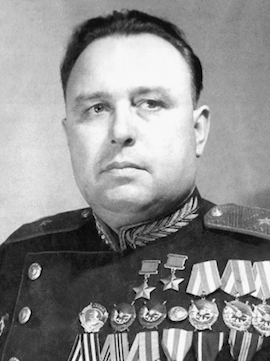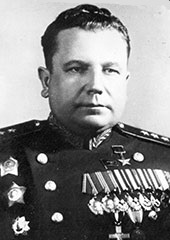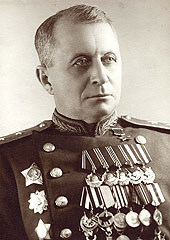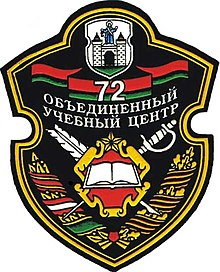
The 8th Guards Order of Lenin Combined Arms Army is an army of the Russian Ground Forces, headquartered in Novocherkassk, Rostov Oblast, within Russia′s Southern Military District, that was reinstated in 2017 as a successor to the 8th Guards Army of the Soviet Union's Red Army, which was formed during World War II and was disbanded in 1998 after being downsized into a corps. Military Unit в/ч 61877.

The 2nd Guards Tatsinskaya Tank Corps was a tank corps of the Soviet Union's Red Army that saw service during World War II on the Eastern Front of Europe. The unit's most notable moment was in the raid on Tatsinskaya during Operation Little Saturn in World War II. After the war, it continued to serve with the Soviet occupation forces in Central Europe. It was originally the 24th Tank Corps. The formation had approximately the same size and combat power as a Wehrmacht Panzer Division, and less than a British Armoured Division had during World War II.

The 90th Guards Tank Division was a division of the Soviet Army, and then of the Russian Ground Forces.
The 75th Guards Rifle Division was a Red Army infantry division during World War II and afterwards, which later became the 75th Guards Tank Division and was finally disbanded in the 1990s.

The 11th Guards Mechanized Brigade is a unit of the Armed Forces of Belarus based in Slonim. The 11th Guards Brigade traces its history back to the 1942 formation of the 6th Tank Corps of the Soviet Army during World War II.
The 5th Mechanised Corps was a mechanised corps of the Red Army, formed on three occasions. It was first formed in 1934 and was converted into the 15th Tank Corps in 1938. It was reformed in the Far East in 1940 and moved west before the German invasion of the Soviet Union. It fought in the First Battle of Smolensk, losing large numbers of tanks in the Lepel counterattack. The corps was encircled in the Smolensk pocket and after breaking out was disbanded in late August 1941. Its third formation, from elements of the 22nd Tank Corps, occurred in September 1942. The corps fought in: Operation Little Saturn, Operation Gallop, the Second Battle of Smolensk, the Dnieper–Carpathian Offensive, and the Second Jassy–Kishinev Offensive. In September 1944, it became the 9th Guards Mechanised Corps.

Vasily Sergeyevich Arkhipov was an officer in the tank troops of the Red Army who was twice awarded the title Hero of the Soviet Union for his actions in the Winter War and World War II. He rose to the rank of colonel general during the Cold War.
The 48th Army was a field army of the Soviet Red Army, active from 1941 to 1945. The army was first formed in August 1941 and fought in the Leningrad Strategic Defensive Operation. The army suffered heavy losses and was disbanded in early September. Its remnants were moved to the 54th Army. Reformed in April 1942 on the Bryansk Front, the army fought in the Maloarkhangelsk Offensive in the winter of 1943. It was sent to the Central Front in March and defended the northern face of the Kursk Bulge. During the summer, it fought in Operation Kutuzov and the Chernigov-Pripyat Offensive. From November, the army fought in the Gomel-Rechitsa Offensive. The army fought in Operation Bagration from June 1944. During the offensive, the army captured Zhlobin and Bobruisk and was on the Narew by early September. During early 1945, the army fought in the East Prussian Offensive and ended the war in East Prussia during May. The army was transferred to Poland in July 1945 and its headquarters was used to form the Kazan Military District in September.
The 70th Guards Rifle Division was formed as an elite infantry division of the Red Army in February, 1943, based on the 1st formation of the 138th Rifle Division in recognition of that division's actions during the battle, and served in that role until well after the end of the Great Patriotic War.
The 307th Rifle Division was raised in 1941 as a standard Red Army rifle division, and served for the duration of the Great Patriotic War in that role. The division distinguished itself in the intense defensive fighting around the village of Ponyri during the Battle of Kursk. It was credited with the liberation of the town of Novozybkov on September 25, 1943. After battling its way through eastern Belarus during the autumn and winter of 1943–44, and then helping complete its liberation during Operation Bagration, it was moved to East Prussia, where it took part in the Battle of Königsberg in the spring of 1945, ending the war on the Baltic coast near the Zemland Peninsula. In the course of these campaigns the 307th compiled a battle record to rival a Guards unit but was nevertheless disbanded on the second-last day of 1945.
The 37th Guards "Rechitsa" Rifle Division was an infantry division of the Red Army which fought during World War II.
The 50th Rifle Division was an infantry division of the Red Army from 1936 to 1946. The division took part in the Soviet invasion of Poland and the Winter War. After Germany launched Operation Barbarossa, the 50th fought in the Battle of Moscow, the Battles of Rzhev, the Donbass Strategic Offensive, the Dnieper–Carpathian Offensive, the First and Second Jassy–Kishinev Offensive, the Vistula–Oder Offensive and the Berlin Offensive.

Filipp Mikhailovich Cherokmanov was a Soviet Army lieutenant general and Hero of the Soviet Union. Cherokmanov joined the Red Army during the Russian Civil War. During the interwar period, Cherokmanov became an officer and commanded the 148th Rifle Division from 1939. He led the division through the Battle of Smolensk and the Battle of Moscow. In February 1942 he became commander of the 6th Guards Rifle Division and was promoted to major general. During summer 1943, he became the commander of the 27th Rifle Corps. Cherokmanov was awarded the title Hero of the Soviet Union for his leadership during the Battle of the Dnieper. He led the corps through the rest of the war, including in the Berlin Offensive. Postwar, Cherokmanov commanded the 29th Guards Rifle Corps, 3rd Army and 7th Guards Army. After becoming deputy commander of the Turkestan Military District, Cherokmanov retired in 1957.

Ivan Tikhonovich Grishin was a Soviet Army Colonel general and Hero of the Soviet Union. Grishin enlisted in the Red Army during the Russian Civil War and fought against the Tambov Rebellion. He became an officer and graduated from the Frunze Military Academy in 1936. In October 1940, he became the commander of the 137th Rifle Division, which he led through the World War II battles of Smolensk and Moscow. Grishin became 50th Army chief of staff and in April 1943 transferred to the same position in the 11th Guards Army. Soon after, he became 49th Army commander and led the army through the Smolensk Operation, Operation Bagration, the East Prussian Offensive and the Berlin Offensive at the end of the war. Postwar, Grishin commanded the 6th Guards Army. In 1946, he became the head of combat training for the Ground Forces. Grishin died in 1951 in Moscow.
The 166th Rifle Division was an infantry division of the Soviet Union's Red Army that fought in World War II, formed twice. The division's first formation was formed in 1939 and wiped out in the Vyazma Pocket in October 1941. In January 1942, the division reformed. It fought in the Battle of Demyansk, the Battle of Kursk, Belgorod-Khar'kov Offensive Operation, Vitebsk–Orsha Offensive, Polotsk Offensive, Šiauliai Offensive, Riga Offensive and the Battle of Memel. It was awarded the Order of the Red Banner.
The 1st Guards Tank Division was a tank division of the Soviet Army from 1945 to 1947, stationed in Neuruppin. It was formed in the spring of 1942 as the 26th Tank Corps. The corps fought in Operation Uranus and became the 1st Guards Tank Corps, being redesignated as a reward for its actions in December 1942. It fought in Operation Gallop, the Third Battle of Kharkov, Operation Kutuzov, Operation Bagration, the East Prussian Offensive, the East Pomeranian Offensive and the Berlin Offensive. During the East Prussian Offensive, the division captured Mława, Działdowo and Płońsk and was awarded the Order of Lenin for its actions. The division had been awarded the honorific "Don" for its actions in Operation Gallop. It also was awarded the Order of the Red Banner and the Order of Suvorov 2nd class.

Alexey Grigoryevich Rodin was a Soviet Army colonel general and Hero of the Soviet Union.

Vasily Alexeyevich Koptsov was a Soviet major general of the Red Army and a Hero of the Soviet Union.

Frants Iosifovich Perkhorovich was a Belarusian Soviet Army lieutenant general and a Hero of the Soviet Union.

Mikhail Alexandrovich Yenshin was a Soviet Army lieutenant general and a Hero of the Soviet Union.











